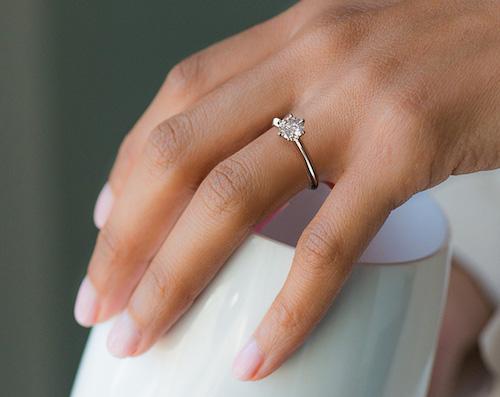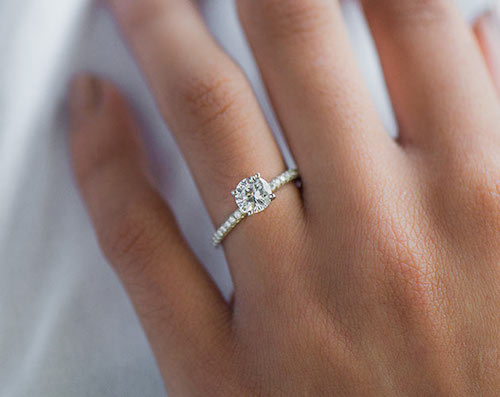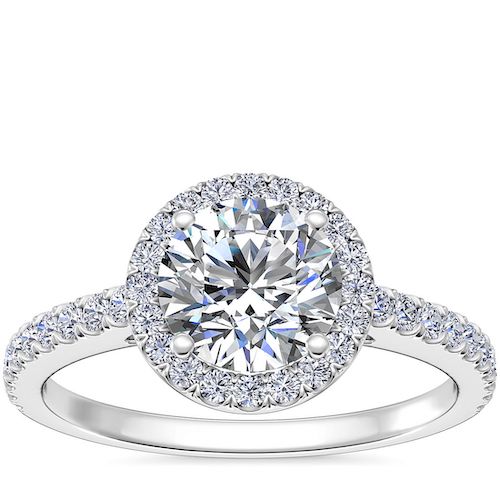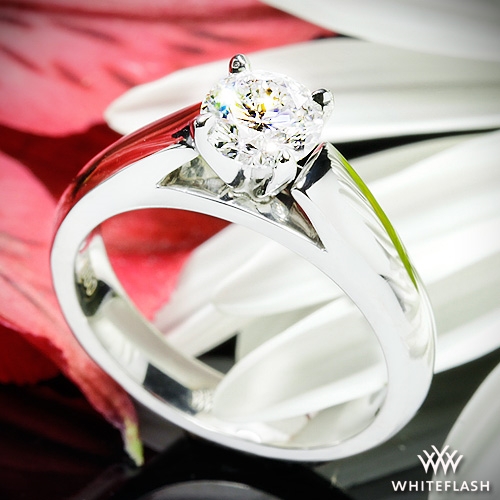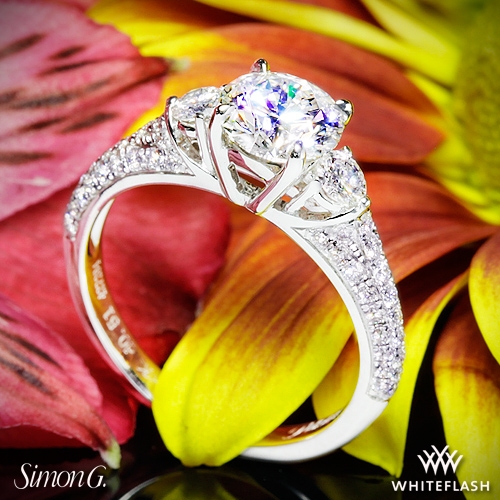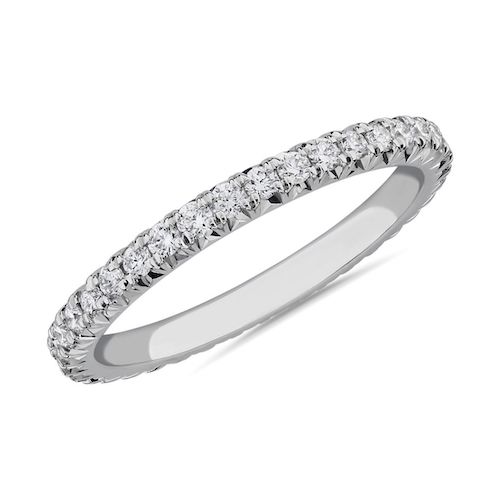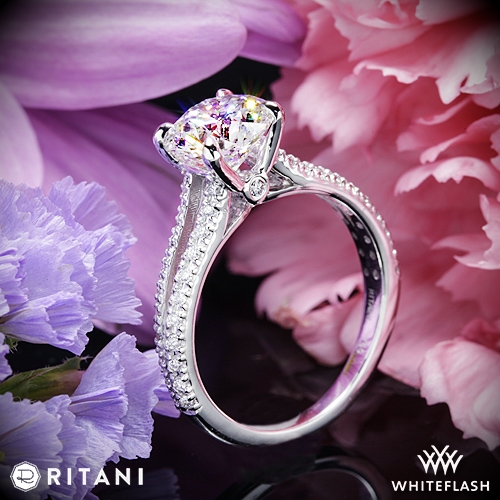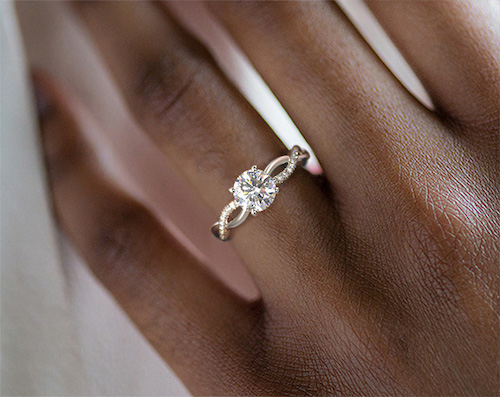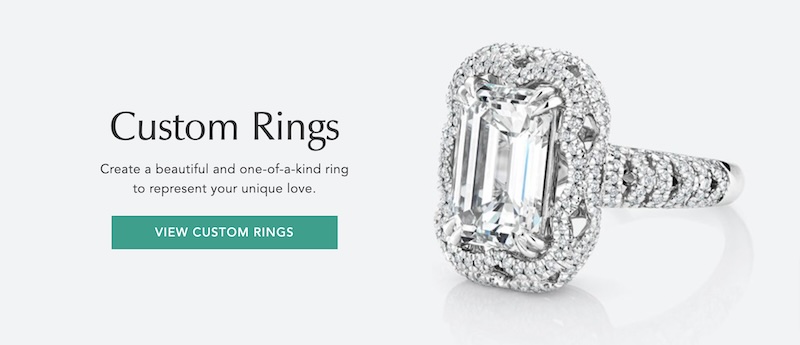
Best Places to Buy Engagement Rings Online
August 24, 2022Choosing the perfect engagement ring is a significant decision, as it symbolizes your love and commitment to your partner. One of the most important aspects to consider when selecting an engagement ring is the style or setting, which plays a crucial role in showcasing the diamond or gemstone and reflecting the wearer's unique personality. With a multitude of ring settings available, it's essential to explore the different options to find the one that resonates with your partner's taste and preferences. In this blog post, we will delve into popular engagement ring styles, discussing their features, benefits, and drawbacks to help you make an informed choice for your perfect ring.
Prong Setting & Solitaire Setting
- Prong Setting: The prong setting is the most common and classic setting for engagement rings. In this setting, metal claws (usually four or six) extend from the band to grip and hold the center diamond or gemstone in place. The prongs can vary in shape, such as round, pointed, flat, or V-shaped.
- Solitaire Setting: A solitaire setting is a ring design that features a single diamond or gemstone as the centerpiece. Typically, solitaire rings utilize a prong setting to hold the stone, but other settings like bezel or tension can also be used to create a solitaire look.
Benefits:
- Showcases the center stone: Prong and solitaire settings allow the diamond or gemstone to be the focal point of the ring, maximizing its visibility and light exposure, which can enhance the stone's brilliance and fire.
- Versatility: These settings are suitable for various diamond shapes and sizes, making them a versatile choice for engagement rings.
- Easy to clean and maintain: With less metal obstructing the center stone, prong and solitaire settings are relatively easy to clean and maintain.
- Timeless appeal: Both prong and solitaire settings have a classic, timeless appeal that never goes out of style, making them a popular choice for engagement rings.
Drawbacks:
- Less protection: Prong settings, in particular, may leave the diamond or gemstone more exposed to potential damage, as the stone is raised above the band.
- Prong snagging: There's a risk of prongs snagging on clothing, hair, or other objects, which can cause discomfort or damage to the ring.
- Prong maintenance: Over time, prongs may wear down, loosen, or break, requiring regular maintenance and inspection to ensure the stone remains secure.
- Simplicity: For some, the simplicity of a solitaire setting may be seen as a drawback if they prefer more intricate designs or additional accent stones.
The Tiffany Setting
The Tiffany setting is a specific type of prong setting, created by the iconic jewelry brand Tiffany & Co. in 1886. It typically features six prongs that hold the center diamond or gemstone, elevating it above the band to allow maximum light exposure for enhanced brilliance.
This setting is specifically designed for round brilliant cut diamonds, but it can also be adapted for other shapes.
The Tiffany setting is often associated with high-quality craftsmanship and has become synonymous with classic, elegant engagement rings.
Benefits:
- Iconic design: The Tiffany setting is instantly recognizable and carries a prestigious reputation, adding a sense of luxury and status to the engagement ring.
- Maximum light exposure: The elevated design of the Tiffany setting allows for maximum light exposure, enhancing the stone's brilliance and fire.
- Timeless appeal: This setting has a timeless appeal that never goes out of style and can be considered a classic choice for an engagement ring.
- Versatile: Though originally designed for round brilliant cut diamonds, the Tiffany setting can be adapted for other shapes as well.
Drawbacks:
- Cost: Tiffany & Co. is a luxury brand, and their patented Tiffany setting comes with a higher price tag (however there's plenty of similar settings available from major vendors).
- Less protection: Similar to the prong setting, the Tiffany setting leaves the diamond more exposed to potential damage due to its raised design.
- Prong snagging and maintenance: As with prong settings, the Tiffany setting may experience snagging on clothing or other objects and may require regular maintenance to ensure the stone remains secure.
Tension Setting
The Tension setting is a unique and modern engagement ring style, where the center diamond or gemstone appears to be suspended or floating between the two ends of the band.
The stone is held in place by the pressure exerted by the metal band, which is precisely crafted to create a secure grip on the stone without the use of prongs or bezels.
This setting is suitable for various diamond shapes and can create a visually striking and contemporary look.
Benefits:
- Modern and unique design: The tension setting offers a distinctive and contemporary look, setting it apart from more traditional engagement ring styles.
- Showcases the center stone: The floating appearance of the stone allows for light exposure from all angles, maximizing its brilliance and fire.
- Minimalist appeal: The sleek design of tension settings can appeal to those who prefer a minimalist and clean aesthetic.
Drawbacks:
- Limited resizing options: Due to the precise nature of the tension setting, resizing may be challenging or even impossible in some cases, which can be a concern if finger size changes over time.
- Less protection: The exposed design of the tension setting may leave the diamond or gemstone more vulnerable to damage, especially along the edges.
- Potential for loosening: Although tension settings are designed to securely hold the stone, there's still a possibility that the metal may weaken or loosen over time, requiring additional maintenance and inspections to ensure the stone remains secure.
Channel Setting
The Channel setting is a popular engagement ring style where smaller diamonds or gemstones are set in a continuous row within a metal channel, typically along the band of the ring.
There are no prongs or other visible means of support for the stones, creating a smooth and sleek appearance.
Channel settings are often used for side stones or accents, but can also be used for the center stone in some designs.
Benefits:
- Sleek and smooth design: The absence of prongs or other visible supports provides a clean, streamlined look that can be especially appealing for those with active lifestyles or professions where snagging could be a concern.
- Enhanced security: The stones in a channel setting are securely held within the metal channel, providing added protection against accidental damage or loss.
- Versatility: Channel settings can be used with various diamond shapes and can be incorporated into a variety of engagement ring designs, from solitaire to three-stone settings.
Drawbacks:
- Limited light exposure: With the stones set within the metal channel, they may receive less light exposure compared to more open settings, which could result in less brilliance and fire.
- Resizing difficulties: Resizing a channel-set ring can be challenging due to the precise nature of the setting and the need to maintain consistent alignment of the stones within the channel.
- Cleaning and maintenance: Channel settings can be more challenging to clean than other settings, as dirt and debris may become trapped within the channel. Regular professional cleanings are recommended to maintain the ring's appearance and ensure the stones remain secure.
Pavé Setting
The Pavé setting, derived from the French word for "paved," is an engagement ring style where numerous small diamonds or gemstones are set closely together, creating a continuous, sparkling surface that resembles a paved road.
The stones are held in place by tiny metal beads or prongs, which are nearly invisible, making the diamonds appear to float on the surface of the metal.
Pavé settings are often used to enhance the band of an engagement ring, adding extra sparkle and visual interest.
Benefits:
- Enhanced sparkle: The close proximity of the diamonds in a pavé setting maximizes their collective sparkle and creates a dazzling effect.
- Complements various styles: Pavé settings can be used to enhance a wide range of engagement ring styles, from solitaires to halo settings, adding extra brilliance and visual appeal.
- Less metal visible: The small beads or prongs holding the stones are nearly invisible, allowing the diamonds to take center stage and minimizing the appearance of the metal.
Drawbacks:
- Resizing challenges: Due to the intricate nature of pavé settings and the close placement of the stones, resizing a pavé-set ring can be difficult and may even require the removal and resetting of the stones.
- Potential for stone loss: Although the tiny beads or prongs in a pavé setting are designed to securely hold the stones, there is still a risk of stone loss, especially with normal wear and tear.
- Cleaning and maintenance: Pavé settings require regular professional cleanings to maintain their brilliance and ensure the stones remain secure. Dirt and debris can become trapped between the closely set stones, making at-home cleaning more challenging.
Halo Setting
The Halo setting is an engagement ring style featuring a center diamond or gemstone encircled by a "halo" of smaller diamonds or gemstones, creating the illusion of a larger, more brilliant center stone.
The halo can be a single row of diamonds or multiple rows and can be designed with various shapes to complement the center stone.
Halo settings often feature pavé or micro-pavé diamonds on the band for added sparkle.
Benefits:
- Enhanced center stone: The halo of smaller diamonds surrounding the center stone can make it appear larger and more brilliant, maximizing its visual impact.
- Increased sparkle: The additional diamonds in the halo and along the band create a dazzling, eye-catching effect that is sure to draw attention.
- Versatility: Halo settings can be designed to complement various diamond shapes and engagement ring styles, allowing for a wide range of customization options.
Drawbacks:
- Potential for stone loss: With numerous small diamonds in the halo and along the band, there is a risk of stone loss, especially with normal wear and tear. Regular inspections and maintenance are necessary to ensure the stones remain secure.
- Cleaning and maintenance: Halo settings require regular professional cleanings to maintain their brilliance, as dirt and debris can become trapped between the closely set stones. At-home cleaning can be more challenging for this intricate setting.
- Resizing difficulties: Due to the intricate nature of halo settings and the close placement of the stones, resizing a halo-set ring can be challenging and may require the removal and resetting of the stones.
Cathedral Setting
The Cathedral setting is an engagement ring style in which the band arches up and forms a graceful curve on either side of the center stone, resembling the arches of a cathedral.
This design provides extra height and prominence to the center stone, making it a visually striking choice.
Cathedral settings can be combined with various diamond shapes and additional design elements, such as pavé diamonds, engraving, or filigree.
Benefits:
- Elevated center stone: The arching design of the cathedral setting adds height and prominence to the center stone, making it a visually appealing choice for those who want their diamond to stand out.
- Classic elegance: The graceful curves of the cathedral setting evoke a sense of timeless elegance, making it a popular choice for those seeking a classic, romantic look.
- Versatility: Cathedral settings can be designed to complement various diamond shapes and can be combined with additional design elements, such as pavé diamonds, engraving, or filigree, to create a unique and personalized engagement ring.
Drawbacks:
- Cleaning and maintenance: The arching design of the cathedral setting may collect dirt and debris more easily than other settings, requiring regular professional cleanings to maintain its beauty and ensure the center stone remains secure.
- Potential for snagging: The elevated design of the cathedral setting may be more prone to snagging on clothing or other objects, which could lead to damage or discomfort during everyday wear.
- Resizing challenges: Resizing a cathedral-set ring can be more complex due to the arching design and any additional design elements, such as pavé diamonds or engraving.
Bar Setting
A bar setting is an engagement ring style where diamonds or gemstones are set between vertical metal bars, which securely hold them in place. This setting can be used for individual stones or a series of stones along the band. The metal bars expose the sides of the stones, allowing more light to enter and create added sparkle.
Benefits:
- Contemporary look: The clean lines and geometric design of the bar setting give it a modern, sleek appearance that appeals to those who prefer contemporary jewelry styles.
- Enhanced sparkle: With the sides of the stones exposed, more light can enter, resulting in greater brilliance and sparkle.
- Secure setting: The vertical metal bars provide a secure setting for the stones, reducing the risk of damage or loss during daily wear.
Drawbacks:
- Less comfortable: The metal bars between the stones may be less comfortable than other settings, as they can press against the finger during wear.
- Limited design options: The bar setting has a specific, streamlined aesthetic that may not be as versatile or easily customizable as other engagement ring styles.
- Resizing challenges: Depending on the design, resizing a bar-set ring can be more complex, as it may require adjustments to the metal bars and potentially the stones.
Flush Setting
A flush setting, also known as a gypsy or burnished setting, is an engagement ring style where the diamond or gemstone is set flush with the surface of the band. The stone is held in place by a small metal lip or rim that secures it within a hole drilled into the band. This setting is known for its sleek, modern appearance and unobtrusive design.
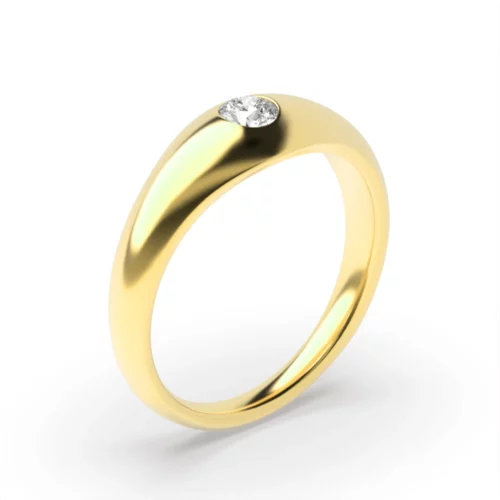
Benefits:
- Sleek and modern: The flush setting offers a clean, contemporary look that appeals to those seeking a minimalist and unpretentious engagement ring style.
- Comfort and durability: With the stone set flush with the band, this setting is comfortable to wear and less likely to snag on clothing or other objects. The design also provides added protection for the stone, making it a durable choice for daily wear.
- Suitable for active lifestyles: The flush setting is an ideal choice for those with active lifestyles, as it offers a low-profile design that reduces the risk of damage during physical activities.
Drawbacks:
- Limited sparkle: Since the stone is set flush with the band, it may not catch as much light as other settings, resulting in less brilliance and sparkle.
- Resizing challenges: Resizing a flush-set ring can be more complex, as it may require adjustments to the metal lip or rim that holds the stone in place.
- Cleaning and maintenance: Although the flush setting offers added protection for the stone, dirt and debris can accumulate in the hole, requiring regular professional cleanings to maintain its beauty and ensure the stone remains secure.
Three-Stone Setting
The three-stone setting, also known as a trilogy or trinity setting, is an engagement ring style that features three diamonds or gemstones set closely together on the band. The center stone is typically larger than the two side stones, which may be the same shape as the center stone or a complementary shape. This setting is symbolic of a couple's past, present, and future together.
Benefits:
- Symbolic meaning: The three-stone setting represents the couple's journey, with each stone symbolizing the past, present, and future, making it a meaningful choice for an engagement ring.
- Enhanced visual impact: With three stones set closely together, this setting creates a visually striking appearance that showcases the beauty of the selected diamonds or gemstones.
- Customizable design: The three-stone setting offers the flexibility to mix and match different shapes, sizes, and types of stones, allowing couples to create a unique and personalized engagement ring.
Drawbacks:
- Increased maintenance: With three stones set closely together, a three-stone setting may require more cleaning and maintenance to ensure that all stones remain secure and maintain their sparkle.
- More expensive: Due to the use of multiple stones, a three-stone setting may be more costly than other engagement ring styles, particularly if high-quality diamonds or gemstones are chosen.
- Potential for snagging: Although the three-stone setting offers a visually striking appearance, the additional stones may increase the risk of snagging on clothing or other objects during daily wear.
Cluster Setting
A cluster setting is an engagement ring style where multiple smaller diamonds or gemstones are grouped to create the appearance of a larger, more impressive center stone. The stones can be arranged in various patterns, such as a flower, a geometric shape, or a more random design. This setting allows for greater creativity and customization while often being more budget-friendly compared to a single large stone.
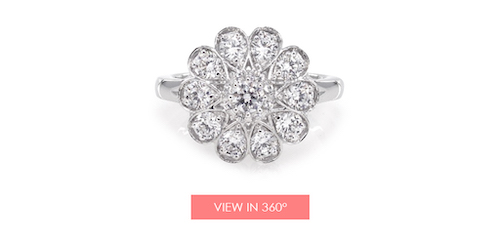
Benefits:
- Unique and customizable: The cluster setting offers numerous design possibilities, allowing couples to create a one-of-a-kind engagement ring that reflects their personal style and preferences.
- Budget-friendly: By using multiple smaller stones instead of a single large stone, the cluster setting can be more affordable while still providing a visually impressive appearance.
- Enhanced sparkle: The arrangement of multiple stones in a cluster setting can create more facets and angles for light to reflect, resulting in increased sparkle and brilliance.
Drawbacks:
- Complex maintenance: Due to the intricate design and numerous stones in a cluster setting, the ring may require more frequent cleaning and professional maintenance to ensure all stones remain secure and maintain their sparkle.
- Less traditional: Some individuals may prefer a more traditional solitaire engagement ring over the unique appearance of a cluster setting.
- Potential for snagging: The multiple stones and intricate design of a cluster setting may increase the risk of snagging on clothing or other objects during daily wear.
Eternity Band
An eternity band is a type of engagement or wedding ring that features a continuous line of identically cut diamonds or gemstones that encircle the entire band. This style symbolizes eternal love and commitment, making it a popular choice for both engagement and wedding rings. Eternity bands can be worn alone or stacked with other rings for added visual interest.
Benefits:
- Symbolic meaning: The continuous circle of diamonds or gemstones represents eternal love and commitment, making the eternity band a meaningful choice for an engagement or wedding ring.
- Versatility: Eternity bands can be worn alone or stacked with other rings, allowing for a variety of looks and styles to suit different preferences.
- Enhanced sparkle: The full circle of stones in an eternity band maximizes the sparkle and brilliance, creating a visually striking appearance.
Drawbacks:
- Resizing difficulties: Due to the continuous circle of stones, resizing an eternity band can be challenging and, in some cases, impossible. It is crucial to ensure the correct ring size before purchasing an eternity band.
- Increased maintenance: The multiple stones in an eternity band may require more frequent cleaning and professional maintenance to ensure all stones remain secure and maintain their sparkle.
- Comfort: Some individuals may find eternity bands to be less comfortable than other ring styles, as the diamonds or gemstones encircle the entire band and may rub against the adjacent fingers.
Shank/Split-Shank
A shank or split-shank setting refers to the design of the band in an engagement ring. In a split-shank setting, the band splits into two or more strands as it approaches the center stone, creating a unique and visually interesting appearance. This design can add an extra flair to the engagement ring and can be customized with various patterns, metal choices, and additional diamond accents.
Benefits:
- Unique and customizable: The split-shank setting offers a distinctive look and can be customized with different patterns, metal choices, and diamond accents, allowing couples to create a personalized engagement ring that reflects their style.
- Enhanced visual impact: The split-shank design adds extra flair and visual interest to the engagement ring, making it an eye-catching choice for those who prefer a more elaborate style.
- Complementary to center stone: The split-shank design can help to accentuate the center stone, drawing attention to its beauty and making it appear larger.
Drawbacks:
- Increased maintenance: The intricate design of a split-shank setting may require more frequent cleaning and professional maintenance to ensure all stones remain secure and maintain their sparkle.
- Potential for snagging: The multiple strands of a split-shank setting may increase the risk of snagging on clothing or other objects during daily wear.
- More expensive: Due to the intricate design and potential use of additional diamond accents, a split-shank setting may be more costly than other engagement ring styles.
Infinity Setting
An infinity setting is an engagement ring style featuring a band that incorporates the infinity symbol or a twisted design, often with diamond accents, to create a continuous and looping pattern. This design symbolizes eternal love and commitment, making it a meaningful choice for an engagement ring. The infinity setting can be paired with various center stone shapes and sizes for a unique and personalized look.
Benefits:
- Symbolic meaning: The infinity setting represents eternal love and commitment, making it a sentimental choice for an engagement ring.
- Unique and customizable: The infinity design can be paired with various center stone shapes and sizes, allowing couples to create a personalized engagement ring that reflects their style and preferences.
- Enhanced visual interest: The twisting pattern of the infinity setting adds extra flair and visual interest to the engagement ring, making it an eye-catching choice for those who prefer a more elaborate style.
Drawbacks:
- Increased maintenance: The intricate design of an infinity setting may require more frequent cleaning and professional maintenance to ensure all stones remain secure and maintain their sparkle.
- Potential for snagging: The looping pattern of an infinity setting may increase the risk of snagging on clothing or other objects during daily wear.
- More expensive: Due to the intricate design and potential use of additional diamond accents, an infinity setting may be more costly than other engagement ring styles.
Conclusion
If you also need help with your diamond, drop me a message otherwise I'd recommend reading my reviews on Whiteflash, James Allen and Blue Nile.

I’m Jasmin, and alongside my partner Ben, our fascination with diamonds began when we were selecting our engagement rings. This initial interaction sparked a passion that drew us deep into the world of gemology and the diamond trade. Our mission is to leverage this expertise to guide you to find the highest quality diamonds at the most affordable prices. We were once clueless shoppers too, and now we’re thrilled to share our knowledge, helping you discover the remarkable intricacies of diamonds that go beyond their surface beauty.


